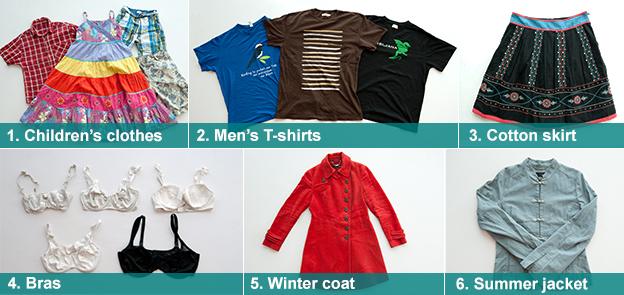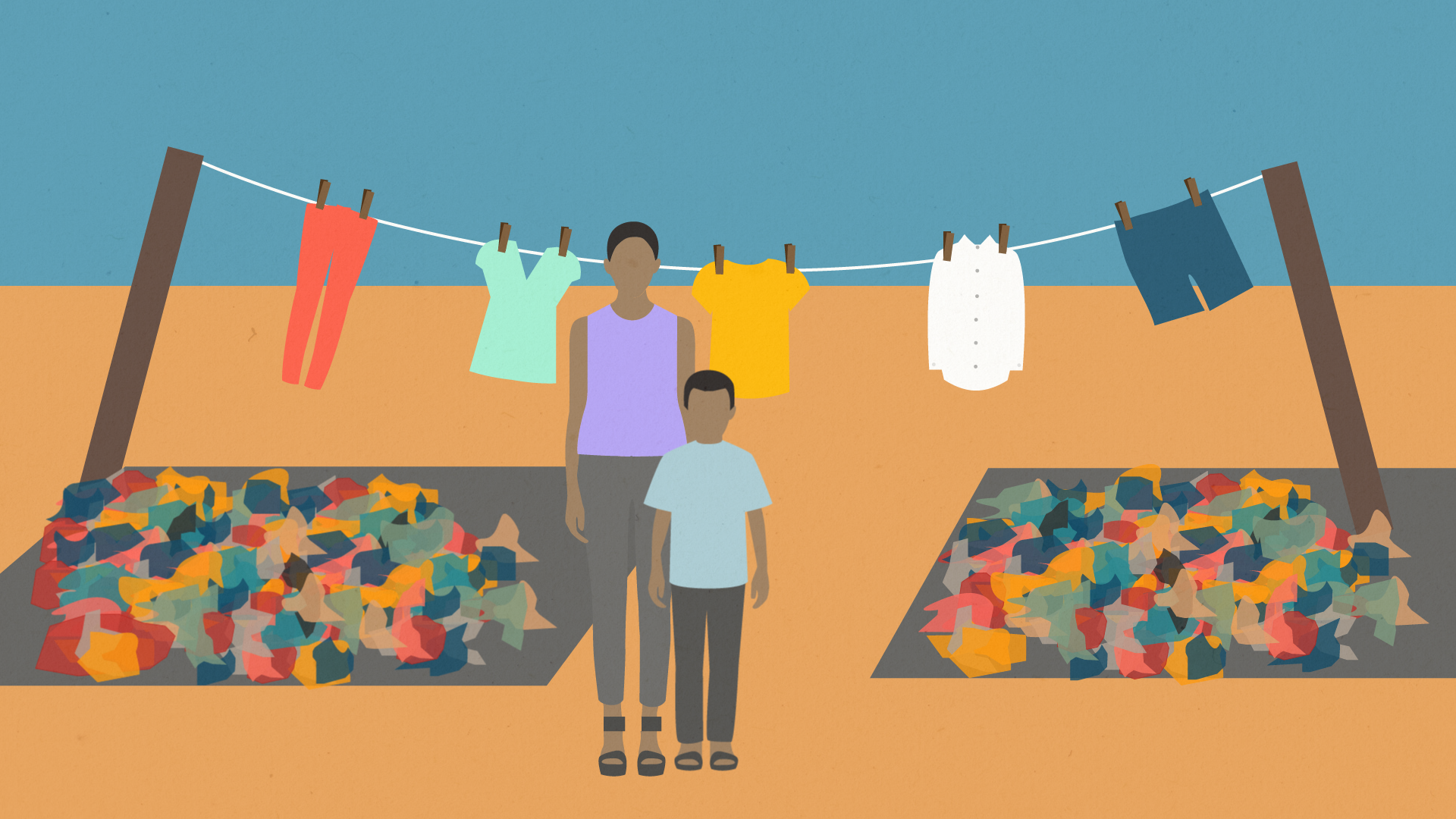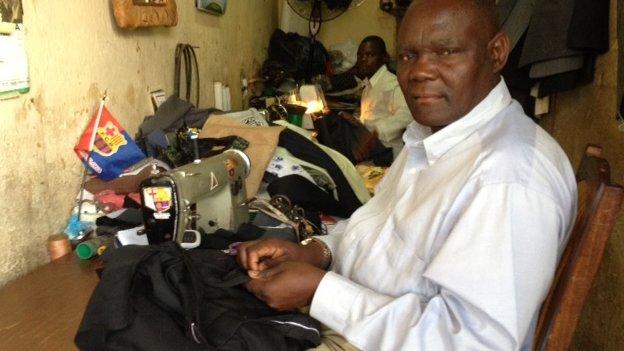Where do your old clothes go?
- Published
Every year, thousands of us across the UK donate our used clothing to charity - many in the belief that it will be given to those in need or sold in High Street charity shops to raise funds. But a new book has revealed that most of what we hand over actually ends up getting shipped abroad - part of a £2.8bn ($4.3bn) second-hand garment trade that spans the globe. We investigate the journey of our cast-offs and begin to follow one set of garments from donation to their eventual destination.
How charity clothing donations end up traded abroad.
UK consumers ditch more than a million tonnes of clothing every year.
The Western world's growing desire for fast, disposable fashion, fuelled by the ready supply of cheap goods manufactured in China and elsewhere, means we are consuming and then disposing of an ever greater quantity of garments.
And, encouraged by charities and recycling companies, we are handing more and more of these old clothes over - via shops, collection bags or clothing banks - for reuse by new owners.
Almost half of the garments we now throw out end up going to a new home rather than ending up in landfill or at an incineration plant, estimates the Waste & Resources Action Programme (Wrap), external, a UK government and EU-backed agency tasked with reducing waste.
Few would dispute that diverting clothing away from landfill and giving it a new life is a good thing.
But Dr Andrew Brooks, lecturer in development geography at King's College London, external, argues in his book Clothing Poverty, external that many donors don't realise that the majority of the cast-offs they hand over to charity will be traded abroad for profit.
"The way most people encounter the second-hand clothing trade is their High Street second-hand store. I think there is a common presumption amongst the general public that if they give something to charity it's most likely to be sold in one of these shops, " he says.
"And while many garments are sold in these shops, the demand is relatively low compared to the supply, and far more get exported overseas."
Clothing in the UK
£44bn
spent annually on clothes
£4,000
worth of clothes in average household
-
30% in average wardrobe has not been worn in a year
-
£140m worth of clothing goes to landfill each year
Wrap estimates that more than 70% of all UK reused clothing heads overseas - joining a global second-hand trade in which billions of old garments are bought and sold around the world every year.
According to the latest available UN figures, external, the UK is the second largest used clothing exporter after the US. It exported more than £380m ($600m), or 351,000 tonnes, worth of our discarded fashion overseas in 2013. Top destinations were Poland, Ghana, Pakistan and Ukraine.
The US's key trade partners are Canada, Chile, Guatemala and India.

Source: The United Nations Comtrade Database - latest available full figures from 2013
So, how do our shirts, trousers, jeans and dresses end up thousands of miles away in a Polish thrift store or street market in Ghana?
The international journey of our cast-offs begins when charities sell on the clothing that cannot be sold in the UK's 10,000 charity shops.
The UK Charity Retail Association, external says 90% of garments handed over directly to shops "end up on the rack in store".
However, according to Brooks, as little as 10-30% of what is given to UK charities overall actually ends up being sold over the counter. It is a similar proportion in the US and Canada.
What isn't bought in shops is, more often than not, Brooks says, sold to textile merchants, who then sort, grade and export the surplus garments - converting what began as donations into tradable goods.
"There's a moment of magic where a gift turns into a commodity," says Brooks. "Like many used items, on the surface second-hand clothes may appear to have very little value, but through processes of sorting and transporting - turning disorderly objects into an ordered commodity - they are reproduced as retailable assets."
One of those businesses transforming our cast-offs is London-based family firm LMB Textile Recycling, external.
Director Ross Barry and his staff collect the contents of clothing banks - sometimes on behalf of charities - and check them by hand for quality. Those that pass the test are baled together and exported to the company's regular customers in Eastern Europe and Africa, where the garments are highly valued.
"They get cheap, affordable clothing that works for them, that's fashionable and that lasts a long time," he says.

Testing the system: Tracking six items of clothing

The onward journey of our clothing depends very much on what we have donated - different garments tend to end up in different places.
For example, Andrew Brooks's research found that white dress-shirts regularly headed to Pakistan, where there was a great demand among lawyers - warm coats often travelled to Eastern Europe, and short-sleeved tops and shorts, perhaps predictably, ended up in Africa.
We have handed over six items or groups of clothing, pictured above, and have started tracking them via GPS. We will report the results if and when they have reached their destinations.

So, much of the UK's donated clothing - along with thousands of tonnes more from the rest of Western Europe and North America - ends up being sold to buyers in developing economies.
Is this necessarily a bad thing?
Brooks believes it is and argues that the flow of old clothing from the Western world - as well as the availability of cheap, new garments from East Asia - has had a negative effect on local textile industries in many countries. This is particularly so in Sub-Saharan Africa, where a third of all globally donated clothes are sold, he says.
Since the 1980s and 90s, used clothing has gained a significant market share across Kenya, Malawi, Mozambique, Nigeria, Rwanda, Senegal, Swaziland, Tanzania, Zambia and Zimbabwe. In Uganda, second-hand garments now account for 81% of all clothing purchases, his research found.
The personal shoppers of Uganda's street markets
The Ugandan personal shopper scouring Kampala's busiest second-hand clothes markets for bargains
Brooks points to Ghana as an example of a country where local industries have been particularly negatively affected - its textile and clothing employment fell by 80% between 1975 and 2000. Nigeria's 200,000-person textile workforce has also all but disappeared, he says.
But for the charity sector, selling on the clothing that can't be sold in shops remains a key source of income.
"The important thing is that charities maximise every donation, no matter what quality it [donated clothing] is, to help fund their life-changing charity work," a spokesman for the Charity Retail Association says.
Yet, explaining to the public how this international process works - the fact that many donations end up exported through textile traders, often to the developing countries NGOs are trying to help - is a difficult prospect.
Ian Falkingham, a former Oxfam area shop manager who now works for the charity in Senegal, acknowledges that questions remain over the transparency of relationships between textile traders and some charities.
In order to avoid this dependency on middlemen, some organisations, including Oxfam and the Salvation Army,, external have set up their own recycling businesses.
"We've worked really hard to move away from that model," Falkingham says.

The language of second-hand clothing

Nigeria: "okirika" (bend down boutique) or even "London clothes"
Ghana: "obroni wawu" (clothes of the dead white man)
Zambia: "salaula" ('selecting from a bale by rummaging)
Congo: "sola" (to choose)
Zimbabwe: "mupedzanhamo" (where all problems end)
Kenya & Tanzania: "mitumba" (bundles) or "kafa ulaya" (clothes of the dead whites)
Source: Andrew Brooks, Clothing Poverty

He explains how Oxfam's Wastesaver recycling plant in Batley, West Yorkshire, external, not only means the charity no longer has to deal with commercial textile traders, but also allows greater control of the onward journey of all unsold donations.
Out of the 11,000 tonnes of clothing donated to Oxfam every year, 3,000 tonnes (27%) is sold in its shops. Of the remaining 8,000 tonnes, 1,000 tonnes are disposed of and 5,600 tonnes (half of that donated) head abroad to Eastern Europe and East and West Africa.
Falkingham says collecting and selling stock through Oxfam's chain of shops remains the "absolute priority" - it makes the most profit and it helps forge relationships with givers, encouraging better-quality donations.
But there will always be stock "that doesn't sell", he explains, and charities have to find ways of making money out of it - such as selling abroad.
"I think most people would be pleased that their bra ended up in Senegal. I think they would think that was a good use of it."
Inside Lahore's biggest used garment market, Pakistan
A tour of Lahore's largest second-hand clothes market, Lunda Bazaar, in Pakistan.
Oxfam has also attempted to enhance benefits for importers by setting up Frip Ethique, external - a social enterprise in Senegal.
The facility, now overseen by Falkingham, employs 40 local staff to sort 2,000 tonnes of Oxfam's exported clothing (36% of total exports) and sell on to small traders at fair prices. All profits are ploughed back into projects in Senegal.
"We are really now managing to make the trade work for very poor people who would otherwise be excluded from it," Falkingham says.
But Brooks argues that while Oxfam's model is a "pragmatic solution" in the short term, it is a "tiny part" of a massive second-hand clothing sector and doesn't tackle the trade dynamics and systems that, he says, deny the world's poorest "ways to climb out of poverty".

For Ross Barry and his recycling company, the collection, sorting and export of our old clothes presents the only real alternative to dumping in landfill. He also argues it benefits many people up and down the trade chain.
"If we as a company buy it, a charity or a local authority gets paid for it. We also employ lots of staff, so they get paid. It then gets sold to our customers and they employ their own staff within their own company."
Other beneficiaries include destination governments, through import duty payments, and local traders who are, he says, predominantly women.
Barry dismisses suggestions that such buyers are being forced to wear the Western world's cast-offs. Many prefer second-hand garments to the alternative - poorer-quality clothing manufactured in East Asia, he says.
But he does believe charities should be clearer when explaining the true fate of the clothing donations they receive.
"I think for charities, it was a nice easy story for them - that everything that was donated was sold in the charity shop," he says. "But the truth of the matter is, people in the UK, on the whole, don't need to buy cheap clothing."
The fact that many of our old clothes end up overseas should not stop people handing them over to charity, he says, but he welcomes a time when the role of his industry is out in the open.
"People would much rather know the truth - why perpetuate the myth?"

Design by Charlotte Thornton and James Offer, development by Aidan Fewster.
- Published11 February 2015

- Published24 August 2013

- Published26 November 2010